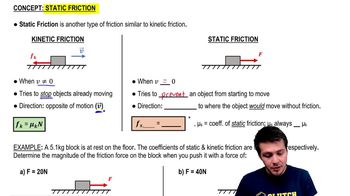Here are the essential concepts you must grasp in order to answer the question correctly.
Forces and Motion
In physics, forces are interactions that cause an object to change its velocity. When analyzing the motion of the lawnmower, we consider the gravitational force acting on it, the normal force from the ground, and the frictional force opposing the motion. Understanding how these forces interact is crucial for determining the net force and the power required to maintain constant speed.
Recommended video:
Solving Motion Problems with Forces
Friction
Friction is the resistance that one surface or object encounters when moving over another. The coefficient of rolling friction quantifies this resistance for rolling objects, such as the lawnmower. It is essential to calculate the frictional force acting on the lawnmower, which directly affects the power needed to push it at a constant speed.
Recommended video:
Static Friction & Equilibrium
Power
Power is defined as the rate at which work is done or energy is transferred over time. In this context, it is important to calculate the work done against friction to maintain the lawnmower's constant speed. The formula for power can be expressed as the product of force and velocity, making it essential to understand how to derive the force from the frictional effects and the angle of the handle.
Recommended video:



